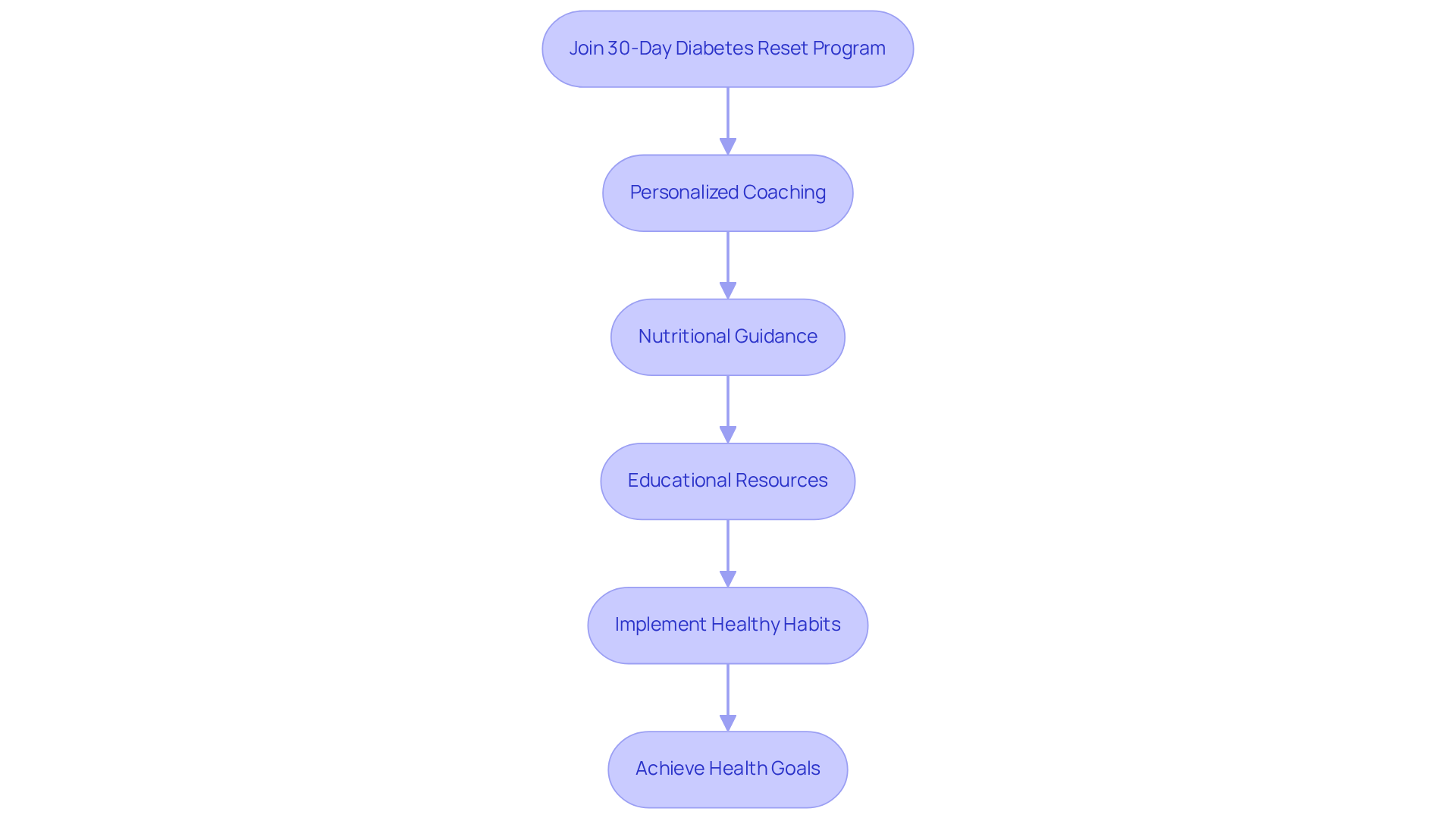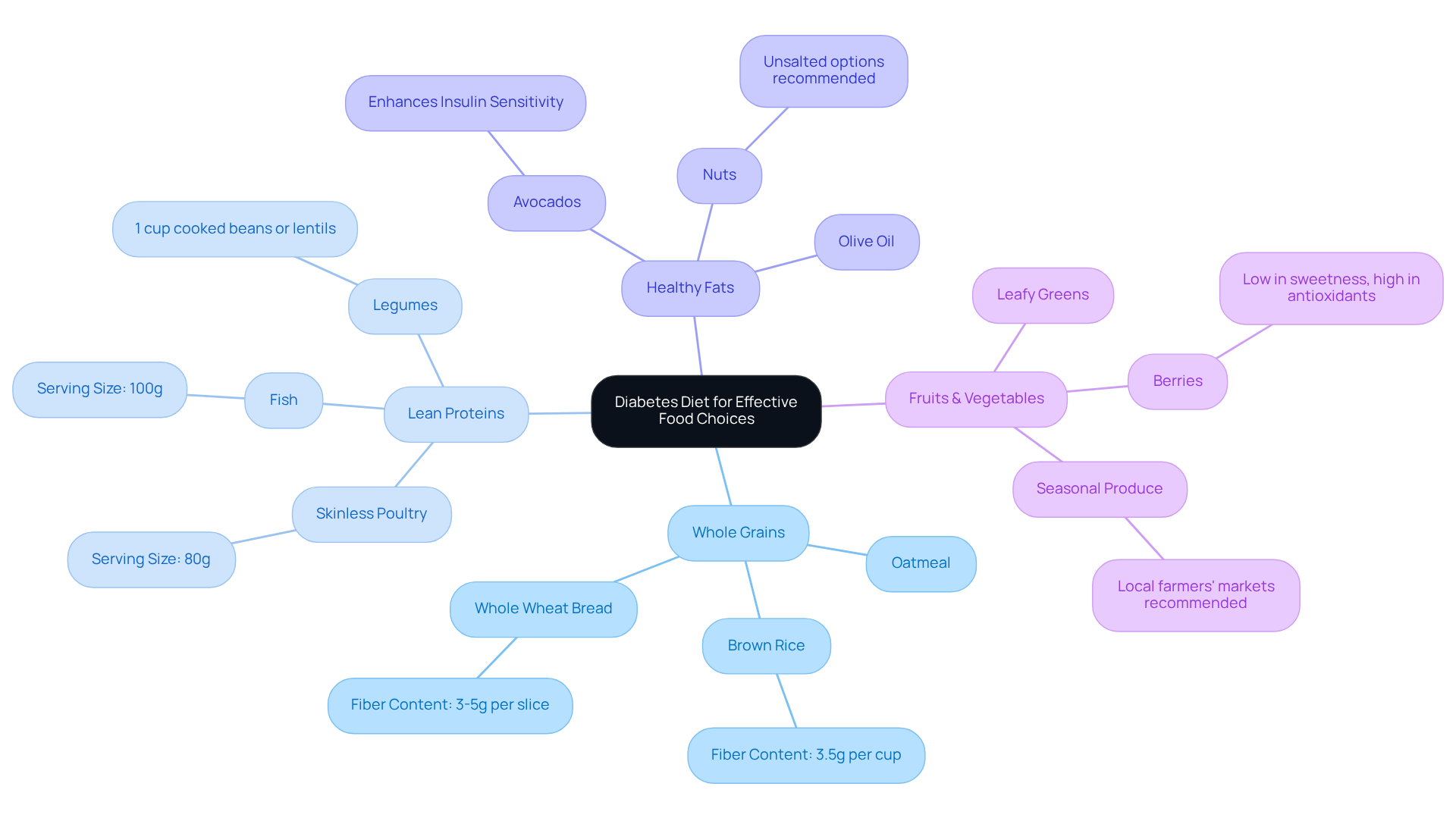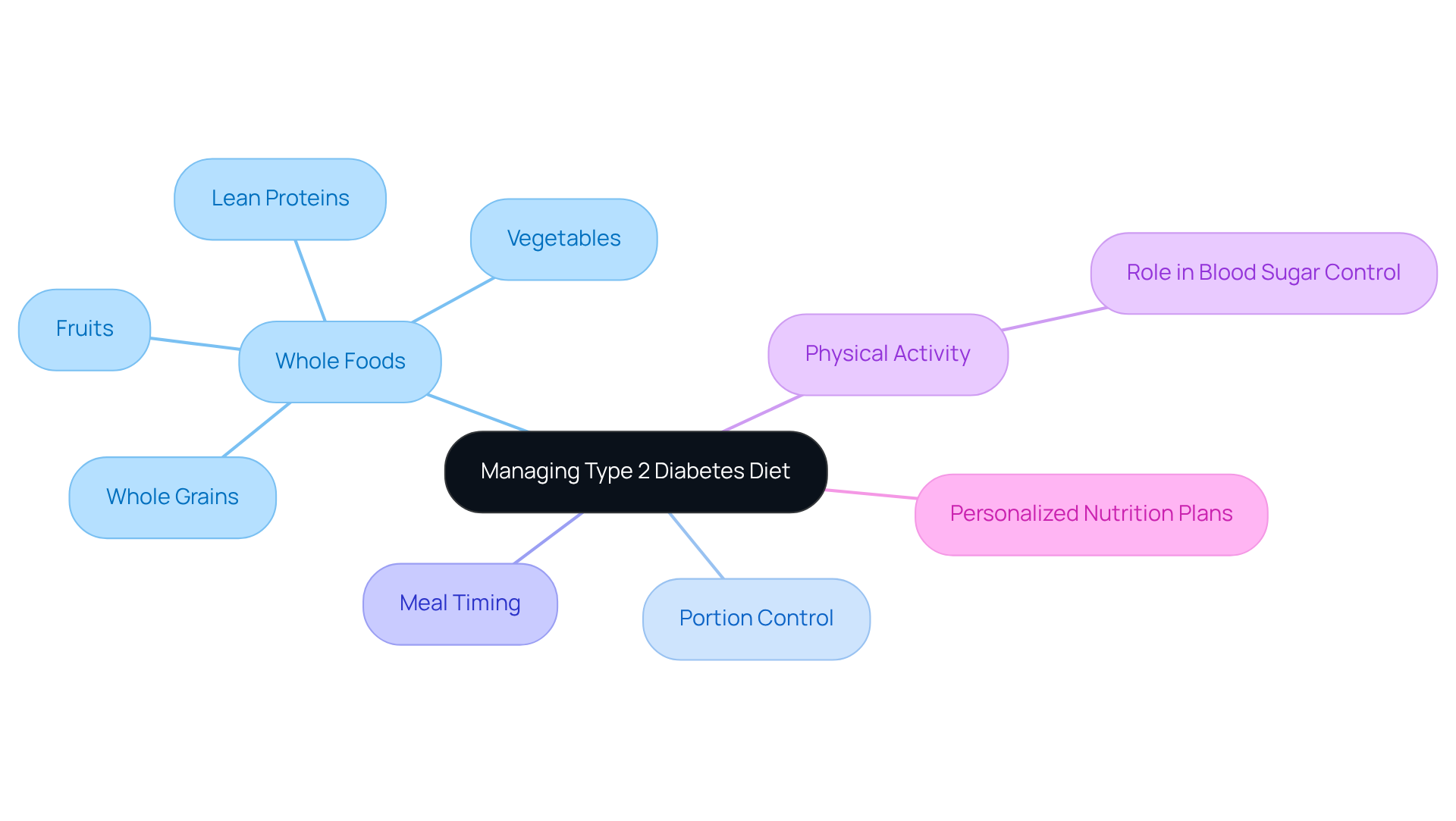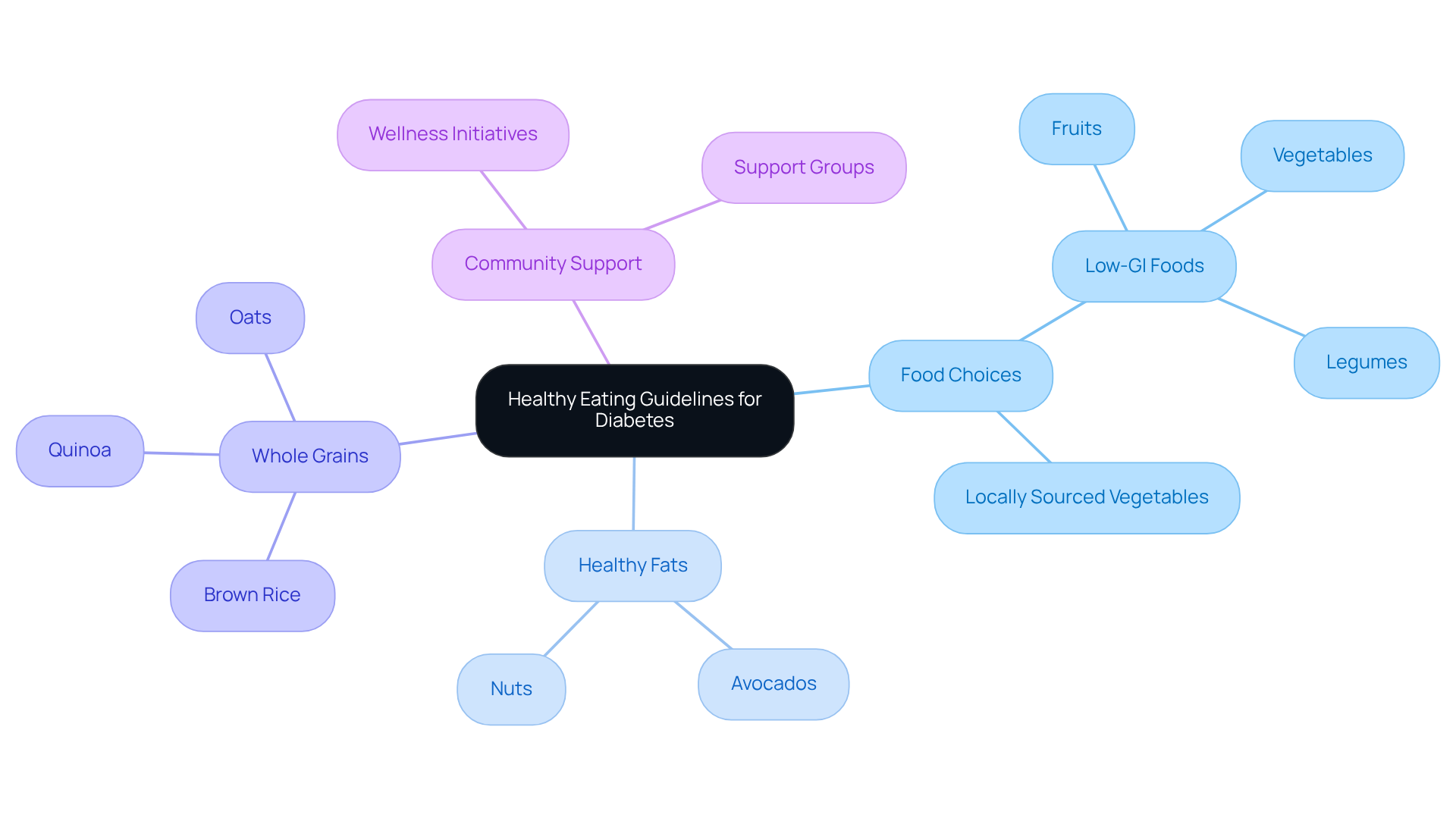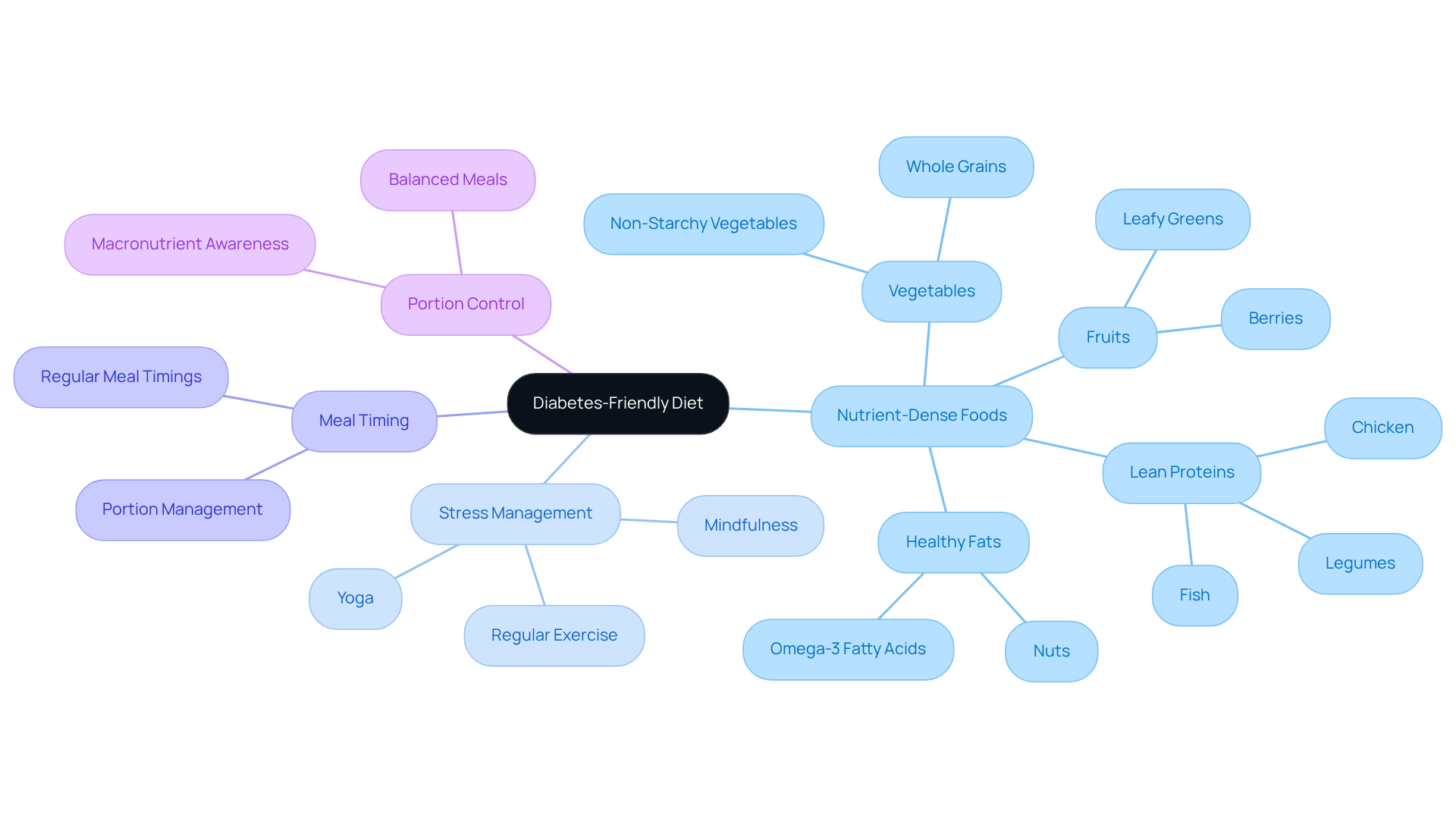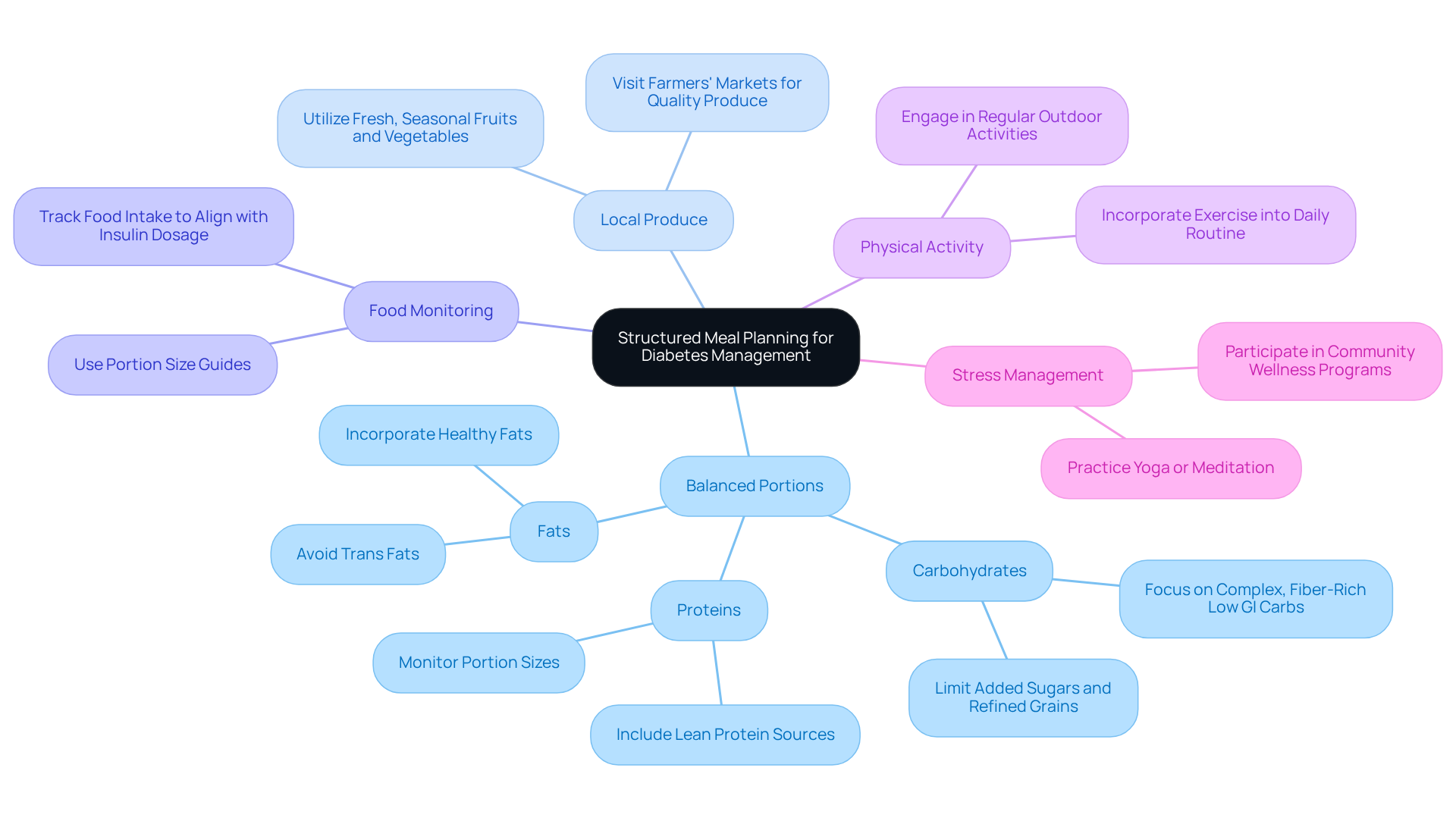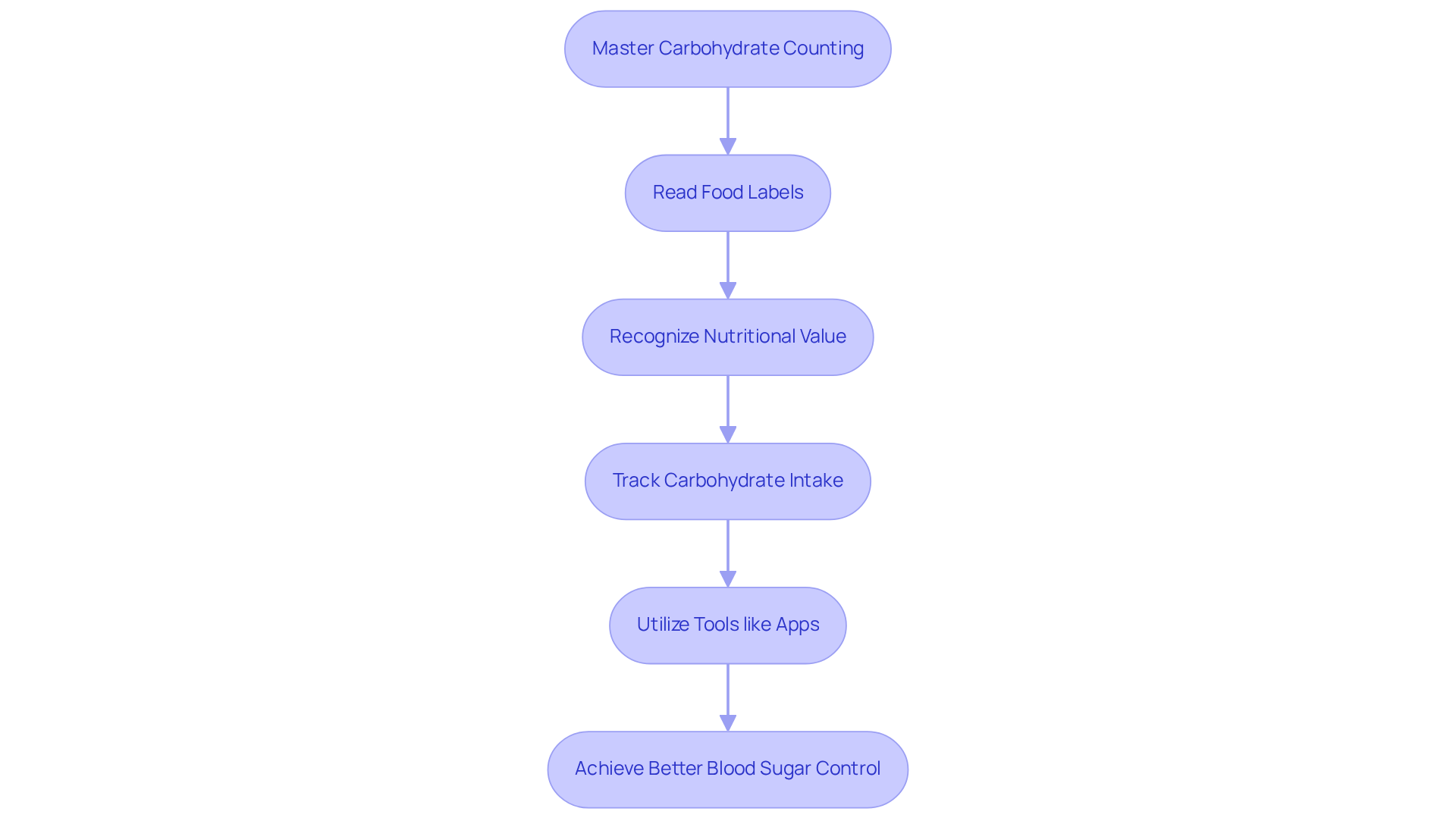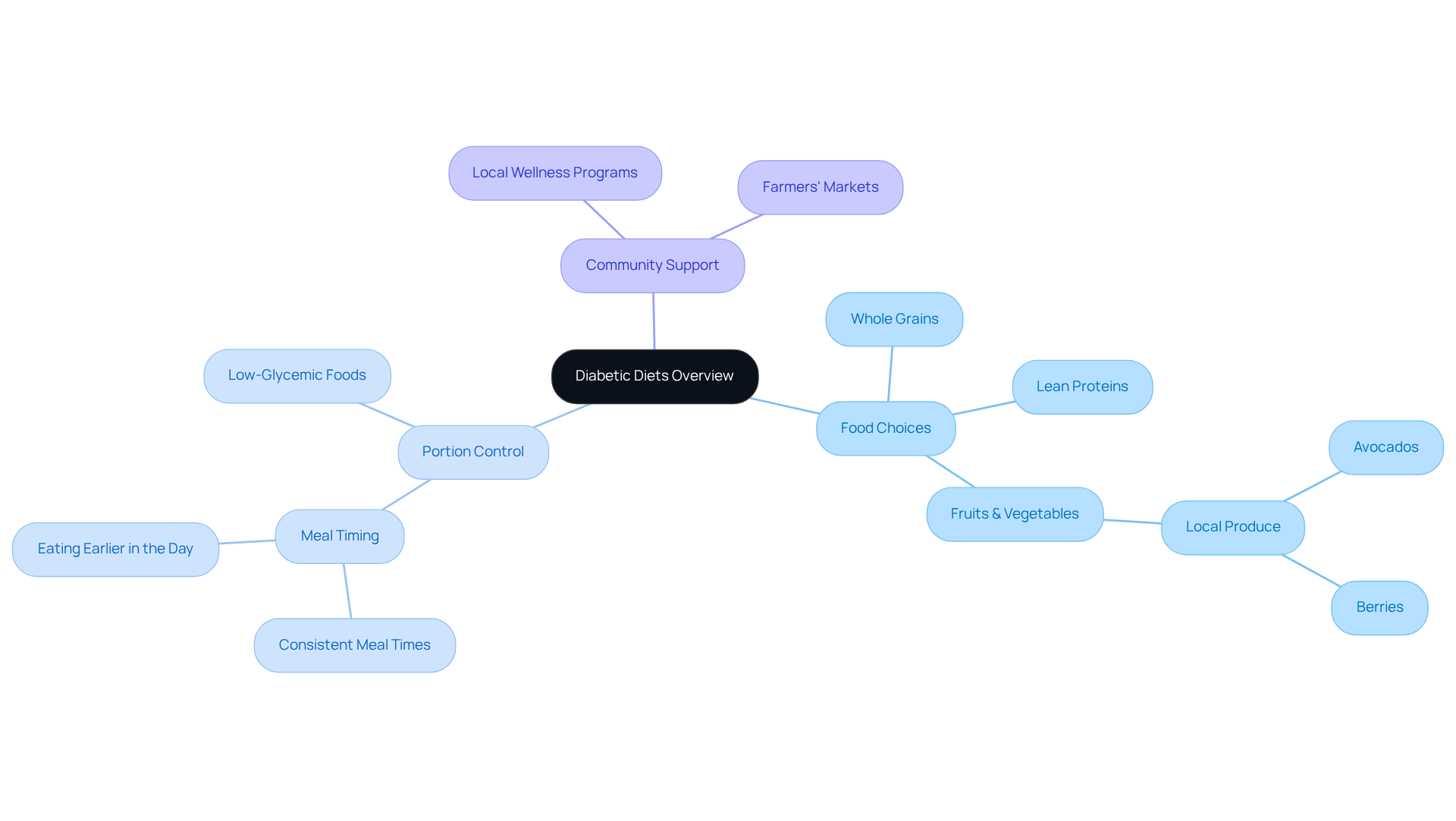Overview
This article highlights the essential foods that individuals with type 2 diabetes can incorporate into their diets for improved blood sugar control. It’s important to recognize that managing diabetes can be challenging, and making the right food choices is a crucial step toward better health. By consuming whole grains, lean proteins, healthy fats, and a variety of fruits and vegetables, individuals can stabilize their glucose levels and enhance their overall well-being. Many patients find that these dietary adjustments, supported by guidelines from health organizations, can lead to significant improvements in their health outcomes.
As you embark on this journey, consider how these food choices can fit into your daily routine. Have you thought about the benefits of whole grains or the role of healthy fats in your meals? Embracing these changes may feel daunting at first, but with time and support, it can become a rewarding part of your lifestyle. Remember, you are not alone in this process, and taking small, manageable steps can lead to lasting change.
Incorporating these foods into your meals is not just about managing diabetes; it’s about nurturing your body and mind. Each meal is an opportunity to care for yourself and promote better health. Let’s explore these options together, and take this step toward a healthier future with compassion and understanding.
Introduction
In the quest for better blood sugar control, making the right dietary choices can truly make a difference. Many individuals face challenges in managing diabetes, often feeling overwhelmed by the wealth of information available. It’s important to recognize that there are a variety of nutrient-rich foods that not only support health but also empower you in your journey toward wellness.
However, navigating through the myriad of options can raise a crucial question: which foods genuinely stand out in promoting effective blood sugar regulation? This article delves into ten essential foods that can transform diabetes management, offering practical insights and actionable tips for those seeking to enhance their well-being.
Integrative Wellness Center: 30-Day Diabetes Reset Program for Lasting Health
Are you feeling overwhelmed by managing your health? The 30-Day Reset Program at the Integrative Wellness Center is here to support you. This program is thoughtfully designed to equip you with essential tools and knowledge for effective management of your condition. With personalized coaching from Dr. Jason Shumard, who brings nearly 20 years of experience in functional medicine, you will receive comprehensive nutritional guidance and educational resources tailored just for you.
Many participants find that gaining insights into healthy eating habits and understanding the importance of physical activity can make a significant difference. It’s important to recognize that maintaining optimal blood sugar levels is not just about addressing symptoms; it’s about exploring the underlying causes of type 2 conditions. This holistic approach fosters improved overall health and well-being.
Success stories from previous participants highlight transformative experiences that inspire hope. For instance:
- One individual lost 55 lbs and saw their A1C drop from 9.1 to 5.7.
- Another shared how they felt energized and no longer needed medications.
These testimonials reflect a renewed sense of control over their health, underscoring the program’s effectiveness in facilitating lasting change.
Additionally, participants will receive Dr. Shumard’s book as a complimentary resource during the program, further enhancing your journey toward better health. By incorporating diabetes type 2 foods to eat, the 30-Day Diabetes Reset Program stands out as a compassionate method for managing type 2 conditions, ultimately leading to a healthier, more empowered lifestyle. Are you ready to take the first step toward a brighter future?
Diabetes Canada: The Diabetes Diet for Effective Food Choices
Diabetes Canada highlights that a balanced diet, particularly diabetes type 2 foods to eat, is essential for effectively controlling blood sugar levels. It’s important to recognize that diabetes type 2 foods to eat emphasize those that are low in sweetness and high in fiber, which are crucial for keeping stable glucose levels. Key components of diabetes type 2 foods to eat consist of:
- Whole grains
- Lean proteins
- Healthy fats
- An abundance of fruits and vegetables
Many patients find that in San Marcos, CA, they can enhance their diabetes management by taking advantage of local farmers’ markets, which offer fresh, seasonal produce like avocados, berries, and leafy greens. These diabetes type 2 foods to eat are not only abundant in fiber and vital nutrients but also help in regulating glucose levels. For example:
- Avocados provide nutritious fats that can enhance insulin sensitivity
- Berries, with their minimal sweetness and rich antioxidant content, are excellent diabetes type 2 foods to eat
By adhering to these recommendations and integrating local dietary habits, individuals can more effectively control their blood sugar levels and lower the chances of complications related to this condition. Furthermore, meal preparation and portion management are vital components of the dietary plan, assisting people in making healthier choices regularly.
Engaging in community wellness programs and outdoor activities can further empower patients in their diabetes management journey, providing support and resources tailored to their unique needs. Remember, taking small steps can lead to significant changes in your health. You’re not alone in this journey, and every effort counts toward a healthier future.
American Diabetes Association: Nutrition and Meal Planning Resources
The American Diabetes Association (ADA) serves as a vital resource for individuals seeking to enhance their nutrition and meal planning skills, particularly regarding diabetes type 2 foods to eat. It’s important to recognize that managing diabetes can be challenging, and the ADA’s guidelines offer compassionate support in this journey. They emphasize the significance of carbohydrate counting, which is crucial for effectively managing glucose levels. By understanding food labels and the carbohydrate content of various foods, individuals can create balanced meals tailored to their health goals.
Many patients find that the ADA’s educational resources clarify how diabetes type 2 foods to eat influence glucose levels, empowering them to make informed dietary choices. Recent guidelines also stress the importance of meal planning, which can greatly improve blood sugar control by fostering consistent eating patterns and portion management, especially when incorporating diabetes type 2 foods to eat. For instance, using the Diabetes Plate method, individuals can visualize their meals, ensuring they incorporate appropriate portions of non-starchy vegetables, lean proteins, and quality carbohydrates.
This organized approach not only simplifies meal preparation but also promotes better health outcomes for those managing their blood sugar levels. Remember, you are not alone in this journey; the ADA is here to support you every step of the way.
Mayo Clinic: Expert Dietary Advice for Managing Type 2 Diabetes
Managing type 2 conditions can be challenging, and professional nutritional guidance plays a crucial role in this journey. It’s important to recognize that whole foods—like fruits, vegetables, whole grains, and lean proteins—are among the diabetes type 2 foods to eat for improving blood glucose regulation. By reducing processed foods and added sweeteners, many patients find that incorporating diabetes type 2 foods to eat can significantly enhance their glycemic control and lower the risk of complications associated with their condition.
Portion control and regular meal timing are vital components of this approach, helping to maintain stable blood sugar levels throughout the day. Have you considered how consistent physical activity can complement your dietary changes? Nutritionists often suggest that integrating exercise into your routine can create a comprehensive strategy for managing blood sugar levels effectively.
Dr. Jason Shumard, a leader in functional medicine at Integrative Wellness Center, emphasizes the importance of personalized nutrition plans tailored to your unique health goals. This individualized approach empowers patients on their management journey. As noted by Mayo Clinic staff, ‘A diabetes type 2 foods to eat diet simply means eating the healthiest foods in moderate amounts and sticking to regular mealtimes.’
Real-life examples from Dr. Shumard’s 30-Day Diabetes Reset program illustrate that participants who embrace these dietary practices frequently report improved health outcomes, including weight loss and increased energy levels. These changes can lead to a better quality of life. To further personalize your dietary strategies, consider consulting with a dietitian who can provide customized meal planning aligned with your health objectives.
Additionally, testimonials from patients highlight the transformative impact of these dietary changes. Many individuals share how adopting a functional medicine approach has made a significant difference in their lives, reinforcing the effectiveness of these practices. Remember, you are not alone on this journey, and support is available to help you thrive.
Better Health Victoria: Healthy Eating Guidelines for Diabetes
At Integrative Wellness Center, we understand the challenges faced by individuals dealing with blood sugar issues. If you’re residing in San Marcos, CA, our clear and practical healthy eating recommendations can make a significant difference in your journey toward better health. We encourage you to select diabetes type 2 foods to eat, including low-GI (glycemic index) foods, and incorporate plenty of locally sourced vegetables into your meals. Whole grains should be your go-to over refined options, as they provide essential nutrients that support your well-being.
It’s important to recognize that healthy fats play a vital role in your diet. Consider including avocados and nuts, which are readily available at local farmers’ markets. These options can nourish your body while helping you avoid trans fats and excessive saturated fats, which can be detrimental to your health. By embracing these recommendations and the vibrant local produce, you can prepare nutritious meals that consist of diabetes type 2 foods to eat, which not only support your health but also help regulate your glucose levels effectively.
Many patients find that participating in community wellness initiatives offers additional support and resources tailored to managing blood sugar levels. This involvement can enhance the overall effectiveness of your dietary changes, providing a sense of connection and encouragement. Remember, you’re not alone on this journey; there are resources and people ready to support you every step of the way.
Livestrong: Comprehensive Guide to a Diabetes-Friendly Diet
Managing diabetes can feel overwhelming, but incorporating diabetes type 2 foods to eat is a crucial step toward effective blood sugar management. It’s important to focus on diabetes type 2 foods to eat that are nutrient-dense and nourish your body. By incorporating diabetes type 2 foods to eat, such as a variety of whole fruits and vegetables, lean proteins, and healthy fats into your meals, you can make significant strides in your health. At the same time, it’s wise to steer clear of sugary snacks and beverages. Research shows that a balanced diet can greatly enhance health outcomes for those with blood sugar concerns. For example, many find that adopting a Mediterranean-style meal pattern, which consists of diabetes type 2 foods to eat that are rich in plant-based foods and healthy fats, helps lower A1C levels and reduce cardiovascular risk.
It’s also essential to consider how stress impacts your health. Integrating stress management techniques, such as mindfulness, yoga, or regular exercise, can be beneficial. Many people discover that these practices help stabilize glucose levels. Additionally, targeted supplements like omega-3 fatty acids and chromium may support metabolic health and improve insulin sensitivity.
Meal timing and portion management are key players in regulating glucose levels. Regular meal timings can help maintain stable glucose levels, and being mindful of macronutrients empowers you to make informed dietary choices regarding diabetes type 2 foods to eat. For instance, diabetes type 2 foods to eat, such as protein-rich options like fish, chicken, and legumes, can aid in glucose regulation, while high-fiber foods like whole grains and non-starchy vegetables support your overall health.
Think about incorporating nutrient-dense foods into your daily routine. Leafy greens, berries, nuts, and low-fat dairy products not only provide essential vitamins and minerals but also support weight management. By adopting these dietary strategies, including diabetes type 2 foods to eat, you can create a sustainable eating plan that promotes better blood sugar control and enhances your overall well-being. Remember, monitoring your progress and setting attainable goals can keep you motivated and dedicated to your dietary changes, ultimately leading to improved health outcomes.
CDC: Structured Meal Planning for Diabetes Management
Structured meal planning that includes diabetes type 2 foods to eat is essential for effective diabetes management, as highlighted by the CDC. It’s important to recognize that by planning meals ahead of time, individuals can focus on achieving balanced portions of carbohydrates, proteins, and fats—key components for maintaining stable blood sugar levels, particularly when selecting diabetes type 2 foods to eat. Utilizing tools and resources for monitoring food consumption not only aids in understanding portion sizes but also empowers individuals to make healthier dietary choices. For instance, a well-structured meal plan, which includes diabetes type 2 foods to eat, can consist of half a 9-inch plate filled with nonstarchy vegetables, one quarter with lean protein, and one quarter with quality carbohydrates, promoting a balanced diet.
In San Marcos, CA, many find that enhancing their meal planning with fresh, local produce from vibrant farmers’ markets makes a significant difference. Seasonal fruits like avocados and berries, along with leafy vegetables, are considered diabetes type 2 foods to eat because they are not only nutritious but also play a vital role in regulating glucose levels. Many patients find that real-world examples demonstrate the success of structured meal planning. Those who adopt this approach often report improved sugar regulation and a decreased risk of diabetes-related complications. Nutritionists emphasize that monitoring diabetes type 2 foods to eat is crucial for effectively managing the condition, as it helps align carbohydrate intake with insulin dosage. This practice can lead to significant improvements in insulin sensitivity and overall health.
Furthermore, research shows that individuals who engage in meal tracking and planning can achieve slight weight loss, which further enhances their ability to regulate blood glucose levels. By incorporating these strategies and focusing on diabetes type 2 foods to eat, people can take proactive steps toward better health and well-being, ultimately leading to a more empowered approach to living with diabetes. Additionally, participating in outdoor activities, like walking or hiking in the beautiful parks of San Marcos, can enrich meal planning by promoting physical fitness, which is essential for managing blood sugar levels. Stress management techniques, such as yoga or meditation, can also be beneficial and are often available through local community wellness programs.
Consulting with a healthcare team, such as Dr. Jason Shumard’s expert team, to identify the best meal pattern for individual needs is crucial. It’s also important to be mindful of portion sizes when dining out, as one entrée can equal 3 or 4 servings. Participating in community wellness initiatives can offer essential assistance and resources tailored for effectively managing blood sugar levels.
Key Tips for Effective Meal Planning:
- Plan meals ahead to maintain balanced portions.
- Incorporate fresh, local produce for nutrition and glucose regulation.
- Monitor food intake to align with insulin dosage.
- Engage in physical activities to support blood sugar management.
- Utilize stress management techniques for overall well-being.
By taking these steps, you can cultivate a healthier lifestyle that empowers you in your journey with diabetes.
Healthline: Top Foods to Incorporate for Diabetes Management
Incorporating leafy greens and berries into your diet can significantly enhance diabetes management—a principle championed by Dr. Jason Shumard at the Integrative Wellness Center. It’s important to recognize that leafy greens, such as spinach, kale, and Swiss chard, are low in calories and carbohydrates while being rich in essential nutrients and antioxidants. These vegetables are important diabetes type 2 foods to eat because they assist in stabilizing glucose levels and decreasing inflammation. For instance, have you considered how a basic salad with assorted greens can serve as a healthy foundation for meals? It offers fiber that helps in glucose regulation.
Berries, particularly strawberries and blueberries, are also excellent choices due to their high antioxidant content and low glycemic index. Many patients find that ingesting polyphenols from berries can enhance insulin sensitivity, which is essential for individuals managing type 2 diabetes. Adding a handful of berries to your breakfast cereals or smoothies not only enhances flavor but also delivers significant health benefits.
Nutritionists emphasize the importance of variety in your diet. Kim Rose-Francis, a registered dietitian, notes that incorporating a range of fruits and vegetables—including leafy greens and berries—can help ensure a well-rounded nutrient intake. This variety not only promotes overall health but also assists in glucose regulation.
Real-life examples of incorporating these foods include:
- Blending spinach into smoothies
- Using kale as a base for hearty salads
These practical applications facilitate the enjoyment of the health advantages of leafy greens and berries while effectively managing blood sugar levels. By prioritizing diabetes type 2 foods to eat and being mindful of limiting high glycemic index options, individuals can take proactive steps toward improved glucose regulation and overall well-being. Dr. Shumard’s tailored support at the Integrative Wellness Center further enables patients to implement these dietary adjustments, cultivating a nurturing community for efficient management of their condition.
Diabetes UK: Carbohydrate Counting for Blood Sugar Control
Effective glucose control is essential, and it often begins with the practice of carbohydrate counting, which helps identify diabetes type 2 foods to eat—a method that diabetes management organizations wholeheartedly endorse. Have you ever felt overwhelmed by food choices? By mastering the skill of reading food labels, you can make informed decisions that directly influence your insulin intake and overall health. This process involves understanding serving sizes, recognizing carbohydrate content, and monitoring your daily intake to maintain optimal glucose levels.
It’s important to recognize that reading food labels goes beyond just counting carbs. Nutritionists emphasize the significance of recognizing the nutritional value of diabetes type 2 foods to eat, including their fiber and protein content, which can enhance satiety and help stabilize blood sugar levels. For instance, choosing diabetes type 2 foods to eat, like low saturated fat protein sources, can support a balanced diet while effectively managing blood sugar.
Many patients find that tracking their carbohydrate intake leads to improved glycemic control and a greater sense of empowerment over their health. Real-world examples show that those who diligently monitor their intake often report positive changes. Tools such as mobile apps can be incredibly helpful in estimating carbohydrate content, making dietary management more accessible and supportive.
Ultimately, the ability to read and understand food labels is a vital skill for anyone managing blood sugar conditions. This knowledge not only fosters improved decision-making but also enhances your quality of life. Remember, you are not alone on this journey; with the right tools and support, you can navigate your health with confidence.
MedlinePlus: Comprehensive Overview of Diabetic Diets
MedlinePlus provides a comprehensive overview of diabetes type 2 foods to eat, emphasizing the essential role of balanced nutrition in effectively managing diabetes. Their guidelines encourage a wide variety of diabetes type 2 foods to eat, emphasizing whole grains, lean proteins, and plenty of fruits and vegetables. In San Marcos, CA, incorporating local produce like avocados and berries can help stabilize glucose levels while offering vital nutrients. Additionally, the lively farmers’ markets in the area provide fresh, seasonal options that are great examples of diabetes type 2 foods to eat.
It’s important to recognize that portion control and meal timing are crucial aspects of diabetes management. Consuming meals at consistent times can significantly influence blood sugar stability. Research shows that eating earlier in the day is linked to better metabolic outcomes, including lower fasting glucose levels and improved insulin sensitivity.
Many patients find that developing a personalized eating plan aligned with their health goals can be beneficial. This may involve strategies such as time-restricted eating or focusing on diabetes type 2 foods to eat, particularly those with a low-glycemic index. For instance, starting your day with a fiber-rich breakfast, like oatmeal topped with berries, can set a positive tone, while avoiding large, high-glycemic meals in the evening can help reduce postprandial glucose spikes.
In addition to these dietary strategies, participating in community wellness initiatives in San Marcos can provide valuable support for managing blood sugar levels. These programs often offer personalized advice, group support, and resources to help you effectively manage your condition. By following these guidelines and embracing the community support available, individuals can take meaningful steps toward managing their diabetes and enhancing their overall health. Consider reaching out to local wellness programs to discover resources that suit your needs.
Conclusion
Incorporating diabetes type 2 foods into daily meals is a pivotal strategy for effective blood sugar management. It’s important to recognize that selecting nutrient-dense options—such as whole grains, lean proteins, and a variety of fruits and vegetables—can greatly support your overall health and help stabilize glucose levels. By understanding and implementing these dietary choices, you can take significant steps toward better health outcomes and an improved quality of life.
Many individuals find that meal planning, portion control, and community support are essential for success. Programs like the 30-Day Diabetes Reset at the Integrative Wellness Center showcase how personalized nutrition guidance can lead to transformative changes, such as weight loss and reduced reliance on medications. Additionally, practical advice from organizations like Diabetes Canada and the American Diabetes Association underscores the importance of carbohydrate counting and understanding food labels to make informed choices.
Ultimately, embracing a holistic approach to managing diabetes—one that includes healthy eating, regular physical activity, and community engagement—can empower you to take control of your health. By focusing on the right foods and utilizing available resources, anyone can embark on a journey toward better blood sugar control and a healthier lifestyle. Remember, every small change contributes to a larger impact, and support is always available to guide you along the way.
Frequently Asked Questions
What is the 30-Day Diabetes Reset Program at the Integrative Wellness Center?
The 30-Day Diabetes Reset Program is designed to support individuals in managing their health, providing essential tools and knowledge for effective management of type 2 diabetes. It includes personalized coaching from Dr. Jason Shumard, who offers comprehensive nutritional guidance and educational resources.
What approach does the program take towards managing type 2 diabetes?
The program adopts a holistic approach that focuses on understanding the underlying causes of type 2 diabetes rather than just addressing symptoms. This method aims to improve overall health and well-being.
Can you share any success stories from the program?
Yes, success stories include individuals who lost significant weight and improved their A1C levels. For example, one participant lost 55 lbs and saw their A1C drop from 9.1 to 5.7, while another reported feeling energized and no longer needing medications.
What resources do participants receive during the program?
Participants receive Dr. Shumard’s book as a complimentary resource, which enhances their journey toward better health.
What are the key components of diabetes type 2 foods to eat according to Diabetes Canada?
Key components include whole grains, lean proteins, healthy fats, and an abundance of fruits and vegetables, which are essential for controlling blood sugar levels.
How can local farmers’ markets benefit individuals managing diabetes?
Local farmers’ markets offer fresh, seasonal produce that is high in fiber and vital nutrients, such as avocados and berries, which help regulate glucose levels.
What is the significance of meal preparation and portion management in diabetes management?
Meal preparation and portion management are vital for making healthier choices regularly, which can enhance blood sugar control and overall health.
What resources does the American Diabetes Association (ADA) provide for nutrition and meal planning?
The ADA offers guidelines on carbohydrate counting, understanding food labels, and meal planning to help individuals manage their diabetes effectively.
How does the ADA suggest individuals visualize their meals?
The ADA recommends using the Diabetes Plate method, which helps individuals visualize their meals to ensure appropriate portions of non-starchy vegetables, lean proteins, and quality carbohydrates.
What support does the ADA offer for individuals managing diabetes?
The ADA provides educational resources and compassionate support to empower individuals in making informed dietary choices and improving their health outcomes while managing diabetes.
